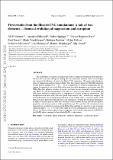| dc.contributor.author | Naiman, Jill P | |
| dc.contributor.author | Pillepich, Annalisa | |
| dc.contributor.author | Springel, Volker | |
| dc.contributor.author | Ramirez-Ruiz, Enrico | |
| dc.contributor.author | Torrey, Paul A. | |
| dc.contributor.author | Vogelsberger, Mark | |
| dc.contributor.author | Pakmor, Rüdiger | |
| dc.contributor.author | Nelson, Dylan | |
| dc.contributor.author | Marinacci, Federico | |
| dc.contributor.author | Hernquist, Lars | |
| dc.contributor.author | Weinberger, Rainer | |
| dc.contributor.author | Genel, Shy | |
| dc.date.accessioned | 2022-07-18T17:08:18Z | |
| dc.date.available | 2021-09-20T18:22:50Z | |
| dc.date.available | 2022-07-18T17:08:18Z | |
| dc.date.issued | 2018 | |
| dc.identifier.uri | https://hdl.handle.net/1721.1/132524.2 | |
| dc.description.abstract | © 2018 The Author(s). Published by Oxford University Press on behalf of the Royal Astronomical Society. The distribution of elements in galaxies provides a wealth of information about their production sites and their subsequent mixing into the interstellar medium. Here we investigate the elemental distributions of stars in the IllustrisTNG simulations. We analyse the abundance ratios of magnesium and europium in Milky Way-like galaxies from the TNG100 simulation (stellar masses log (M*/M⊙) ~ 9.7-11.2). Comparison of observed magnesium and europium for individual stars in the Milky Way with the stellar abundances in our more than 850 Milky Way-like galaxies provides stringent constraints on our chemical evolutionary methods. Here, we use the magnesium-to-iron ratio as a proxy for the effects of our SNII (core-collapse supernovae) and SNIa (Type Ia supernovae) metal return prescription and as a comparison to a variety of galactic observations. The europium-to-iron ratio tracks the rare ejecta from neutron star-neutron star mergers, the assumed primary site of europium production in our models, and is a sensitive probe of the effects of metal diffusion within the gas in our simulations. We find that europium abundances in MilkyWay-like galaxies show no correlation with assembly history, present-day galactic properties, and average galactic stellar population age. We reproduce the europium-to-iron spread at low metallicities observed in the Milky Way, and find it is sensitive to gas properties during redshifts z ≈ 2-4. We show that while the overall normalization of [Eu/Fe] is susceptible to resolution and post-processing assumptions, the relatively large spread of [Eu/Fe] at low [Fe/H] when compared to that at high [Fe/H] is quite robust. | en_US |
| dc.language.iso | en | |
| dc.publisher | Oxford University Press (OUP) | en_US |
| dc.relation.isversionof | 10.1093/MNRAS/STY618 | en_US |
| dc.rights | Creative Commons Attribution-Noncommercial-Share Alike | en_US |
| dc.rights.uri | http://creativecommons.org/licenses/by-nc-sa/4.0/ | en_US |
| dc.source | arXiv | en_US |
| dc.title | First results from the IllustrisTNG simulations: a tale of two elements – chemical evolution of magnesium and europium | en_US |
| dc.type | Article | en_US |
| dc.contributor.department | Massachusetts Institute of Technology. Department of Physics | en_US |
| dc.contributor.department | MIT Kavli Institute for Astrophysics and Space Research | en_US |
| dc.relation.journal | Monthly Notices of the Royal Astronomical Society | en_US |
| dc.eprint.version | Author's final manuscript | en_US |
| dc.type.uri | http://purl.org/eprint/type/JournalArticle | en_US |
| eprint.status | http://purl.org/eprint/status/PeerReviewed | en_US |
| dc.date.updated | 2020-11-12T16:04:17Z | |
| dspace.orderedauthors | Naiman, JP; Pillepich, A; Springel, V; Ramirez-Ruiz, E; Torrey, P; Vogelsberger, M; Pakmor, R; Nelson, D; Marinacci, F; Hernquist, L; Weinberger, R; Genel, S | en_US |
| dspace.date.submission | 2020-11-12T16:04:27Z | |
| mit.journal.volume | 477 | en_US |
| mit.journal.issue | 1 | en_US |
| mit.license | OPEN_ACCESS_POLICY | |
| mit.metadata.status | Publication Information Needed | en_US |
